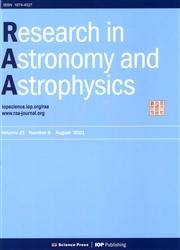宽吸收线与窄吸收线之间的共变性
IF 2.8
4区 物理与天体物理
Q3 ASTRONOMY & ASTROPHYSICS
引用次数: 0
摘要
我们利用包含 134 对 C iv NAL-BAL 的双波长 SDSS 光谱数据集,研究了宽吸收线(BAL)或窄吸收线(NAL)的变化与连续波的变化之间的关系。我们的分析表明,NAL(或 BAL)的分数等效宽度(EW)变化与连续波的分数通量变化之间存在反相关关系,斯皮尔曼秩相关系数分别为 r = -0.47 (p = 1E-08) 和 r = -0.58 (p = 1E-13)。此外,我们还发现 NALs 和 BALs 的分数 EW 变化之间存在正相关(r = 0.72,p = 1E-22),并推导出回归方程 ΔEWNAL/〈EWNAL〉 = 0.803ΔEWBAL/〈EWBAL〉 + 0.008,其内在散度为 0.14。这些结果表明,电离连续相的变化可能在观测到的 C iv NALs 和 BALs 变化中起了重要作用,支持了光离子化驱动变化的观点。C iv NALs 和 BALs 之间的共同可变性可能意味着它们源自物理条件相似的外流。本文章由计算机程序翻译,如有差异,请以英文原文为准。
Co-variability Between the Broad Absorption Lines and Narrow Absorption Lines
We investigate the relationship between the variability of broad absorption lines (BALs) or narrow absorption lines (NALs) and that of continuum using a data set of two-epoch SDSS spectra containing 134 C iv NAL-BAL pairs. Our analysis reveals an anti-correlation between the fractional equivalent width (EW) variations in NALs (or BALs) and the fractional flux variations of the continuum, with Spearman rank correlation coefficients of r = −0.47 (p = 1E-08) and r = −0.58 (p = 1E-13), respectively. In addition, we find a positive correlation between the fractional EW variations in NALs and BALs (r = 0.72, p = 1E-22), and derive a regression equation ΔEWNAL/〈EWNAL〉 = 0.803ΔEWBAL/〈EWBAL〉 + 0.008, with an intrinsic scatter of 0.14. These results suggest that the variability in the ionizing continuum may play a significant role in the observed changes in C iv NALs and BALs, supporting the idea of photoionization-driven variability. The co-variability between C iv NALs and BALs may imply that they originate from outflows with similar physical conditions.
求助全文
通过发布文献求助,成功后即可免费获取论文全文。
去求助
来源期刊

Research in Astronomy and Astrophysics
地学天文-天文与天体物理
CiteScore
3.20
自引率
16.70%
发文量
2599
审稿时长
6.0 months
期刊介绍:
Research in Astronomy and Astrophysics (RAA) is an international journal publishing original research papers and reviews across all branches of astronomy and astrophysics, with a particular interest in the following topics:
-large-scale structure of universe formation and evolution of galaxies-
high-energy and cataclysmic processes in astrophysics-
formation and evolution of stars-
astrogeodynamics-
solar magnetic activity and heliogeospace environments-
dynamics of celestial bodies in the solar system and artificial bodies-
space observation and exploration-
new astronomical techniques and methods
 求助内容:
求助内容: 应助结果提醒方式:
应助结果提醒方式:


